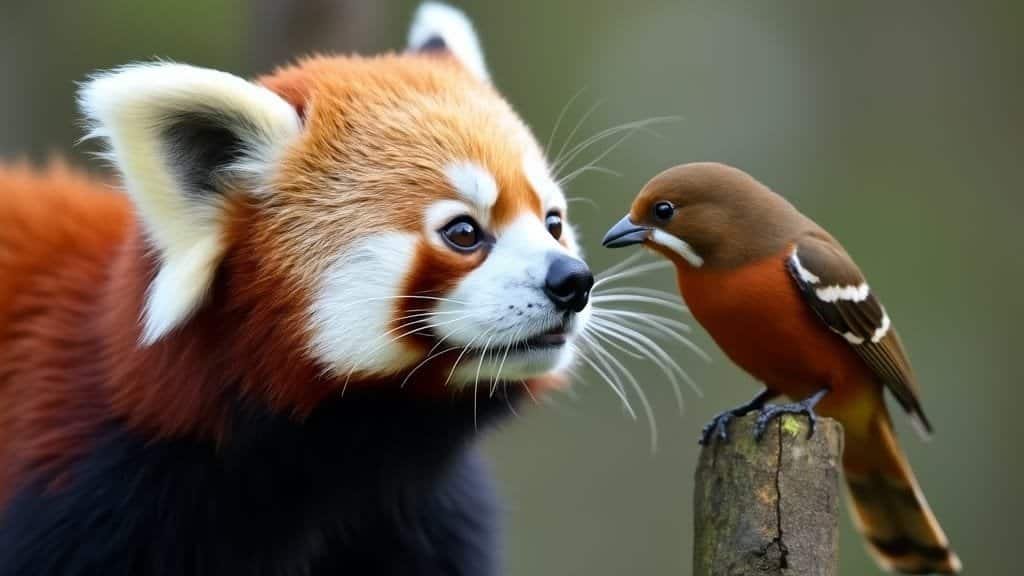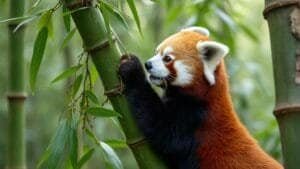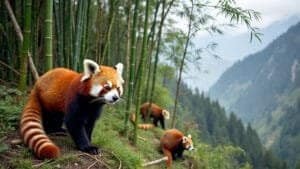Introduction
Red pandas, often considered the guardians of high-altitude forest ecosystems, share their habitat with a variety of species, from predators like snow leopards to competitors such as small herbivores
Their interactions with other forest inhabitants influence biodiversity, ecosystem stability, and the availability of resources like bamboo
This article explores the roles red pandas play in their ecosystems, their relationships with predators and competitors, and how these interactions highlight the need for conservation efforts to protect their habitats
The Role of Red Pandas in Forest Ecosystems
Red pandas are more than just charismatic icons of their forest habitats; they play an essential role in maintaining ecosystem balance
As primarily arboreal mammals, red pandas contribute to forest health through their feeding habits, interactions with vegetation, and indirect effects on biodiversity
Below, we examine how red pandas enhance forest biodiversity, their relationship with bamboo, and their significance as indicators of forest health
How Red Pandas Contribute to Forest Biodiversity
Red pandas are an integral part of the temperate forests in the Himalayas, Myanmar, and southwestern China, where they coexist with a range of other species
By occupying a specific niche as bamboo specialists, red pandas reduce competition for resources among other herbivores. Their foraging behavior also aids in the natural pruning of bamboo shoots, which encourages new growth and maintains the health of bamboo forests
Additionally, red pandas play a role in seed dispersal. While bamboo constitutes the majority of their diet, they occasionally consume berries and fruits
Seeds that pass through their digestive systems are scattered across the forest, promoting the growth of new vegetation and supporting biodiversity. This behavior indirectly benefits other forest inhabitants by ensuring a steady supply of plant resources
The presence of red pandas also has a cascading effect on biodiversity. Their conservation ensures that the habitats they rely on, including bamboo groves and dense understory vegetation, are preserved
This habitat protection extends benefits to numerous other species, including birds, insects, and small mammals that share the forest
The Relationship Between Red Pandas and Bamboo
Bamboo is the cornerstone of a red panda’s diet, comprising up to 95% of their food intake. Red pandas consume tender bamboo shoots, leaves, and stems, which are rich in nutrients but require significant energy to digest
To meet their caloric needs, red pandas spend a large portion of their day feeding, often foraging across multiple bamboo patches within their home ranges
The health of bamboo forests is crucial for red panda survival. However, bamboo is highly sensitive to environmental changes, such as deforestation, overgrazing, and climate change
When bamboo availability declines, red pandas are forced to expand their range in search of food, increasing their vulnerability to predators and human-wildlife conflict
Restoring and preserving bamboo forests not only supports red pandas but also benefits other herbivores that rely on bamboo as a food source
Conservation programs often focus on protecting bamboo habitats, recognizing their central role in sustaining red panda populations and broader forest ecosystems
Red Pandas as Indicators of Forest Health
Red pandas are often considered “umbrella species” because their well-being reflects the overall health of their habitat
When red panda populations thrive, it indicates that the forest ecosystem is intact, with adequate bamboo availability, minimal human disturbance, and balanced biodiversity
Conversely, declines in red panda populations often signal broader ecological issues, such as habitat degradation or climate-related impacts
Monitoring red pandas can provide valuable insights for conservationists seeking to protect temperate forests. For instance, tracking red panda movements and feeding patterns helps identify key areas for habitat restoration and protection
Additionally, red pandas’ sensitivity to environmental changes makes them effective indicators for assessing the success of conservation initiatives
By ensuring the survival of red pandas, conservationists also safeguard the ecosystems they inhabit, benefiting countless other species that share these unique habitats
Interactions Between Red Pandas and Other Forest Species
Red pandas coexist with a diverse array of species in their temperate forest habitats, engaging in various interactions that shape their survival and the dynamics of the ecosystem
From avoiding predators to competing for food and forming neutral or symbiotic relationships, these interactions highlight the complexity of their ecological niche
Predators of Red Pandas: Survival Strategies
Red pandas face threats from several predators, including snow leopards, yellow-throated martens, and occasionally wild dogs (dholes). These predators, which share overlapping territories with red pandas, pose a constant risk, especially to young or solitary individuals
To evade predators, red pandas rely on their arboreal lifestyle, often retreating to the safety of trees when threatened. Their semi-retractable claws and strong, flexible tails allow them to climb with ease and balance on narrow branches
Additionally, their reddish-brown fur provides effective camouflage against the mossy and reddish-barked trees of their habitats
While direct encounters with predators are relatively rare, the mere presence of predators influences red panda behavior. Studies in Nepal have shown that red pandas adjust their activity patterns to avoid predators, often becoming more active during the day to steer clear of nocturnal hunters like snow leopards
These behavioral adaptations help mitigate the risk of predation but can also reduce their foraging efficiency and reproductive success
Competition for Food Resources in the Forest
As bamboo specialists, red pandas compete primarily with other herbivores for access to this critical resource. Species such as takins, gorals, and even domestic livestock like yaks and goats often graze in the same forests, putting pressure on bamboo availability
Overgrazing by livestock, in particular, has been identified as a significant issue in areas where human activities encroach on red panda habitats
Unlike more generalized herbivores, red pandas are highly selective in their bamboo consumption, often favoring specific species or the tender shoots and leaves. This dietary specialization reduces direct competition but makes them more vulnerable to habitat changes that affect bamboo growth
Red pandas also compete with smaller mammals like pikas and hares, which forage for similar resources in the understory vegetation
While these interactions are less direct, they reflect the interconnected nature of forest ecosystems, where the decline or displacement of one species can have cascading effects on others
Symbiotic and Neutral Interactions in Red Panda Habitats
Not all interactions between red pandas and other species are competitive or predatory. Some are neutral or even beneficial, contributing to the overall health of their shared ecosystem
Birds, for example, often forage in the same trees as red pandas, feeding on insects and berries that the pandas do not consume. This coexistence helps maintain the balance of the forest’s food web without significant overlap in resource use
Red pandas may also play a role in controlling bamboo growth. By consuming older shoots and leaves, they allow younger, more nutritious shoots to thrive, benefiting other bamboo-dependent species
Additionally, their scat serves as a natural fertilizer, enriching the soil and promoting vegetation growth
While true symbiotic relationships involving red pandas are rare, their presence in the ecosystem supports a web of interactions that sustain biodiversity. These connections emphasize the importance of preserving red pandas as part of a balanced forest environment
Challenges and Opportunities in Protecting Red Pandas
Protecting red pandas and their interactions with other forest species involves addressing threats from predators, competitors, and human activities while capitalizing on opportunities to strengthen conservation efforts
This section examines the challenges posed by natural and human-induced pressures and explores strategies for fostering coexistence and preserving red panda habitats
Threats from Predators and Competitors
One of the major challenges red pandas face is predation. While their arboreal lifestyle and camouflage provide some protection, young red pandas are particularly vulnerable to predatory attacks by martens and snow leopards
Increased habitat fragmentation exacerbates this threat by limiting safe refuge areas and forcing red pandas into regions with higher predator densities
Competition for resources is another significant issue. The overgrazing of bamboo and other vegetation by domestic livestock, such as goats and cattle, reduces the availability of food for red pandas
This pressure is especially pronounced in regions where human settlements encroach on forested areas. Wild herbivores like takins and gorals also contribute to the competition for bamboo, further limiting resources
Efforts to mitigate these threats include creating protected areas that exclude grazing activities and promoting sustainable livestock management
Establishing wildlife corridors to connect fragmented habitats can also provide red pandas with safer access to resources and reduce their exposure to predators
Conservation Efforts to Preserve Red Panda Habitats
Conservation organizations and governments in red panda range countries have implemented a variety of measures to address the challenges facing red pandas and their ecosystems
These efforts often involve habitat restoration, anti-poaching initiatives, and community-based conservation programs:
Habitat Restoration: Reforestation projects focus on regenerating bamboo forests and reconnecting fragmented habitats. For instance, in Nepal, the Red Panda Network has successfully restored hundreds of hectares of degraded forest, creating corridors that enable red pandas to move safely between territories
Anti-Poaching Measures: Strengthening enforcement against poaching and illegal wildlife trade is essential for protecting red pandas. Conservation initiatives often include training local rangers, equipping them with modern tools like GPS and drones, and increasing patrols in protected areas
Community Involvement: Many conservation programs recognize the importance of local communities in preserving red panda habitats. By engaging residents in monitoring activities and providing alternative livelihoods through ecotourism, these initiatives reduce the economic pressures that drive deforestation and overgrazing
Balancing Ecosystem Protection With Human Activities
Coexistence between humans and red pandas requires a balanced approach that supports both ecological preservation and human development. Programs that integrate traditional knowledge with modern conservation practices can help achieve this balance
For example, rotational grazing systems reduce the impact of livestock on bamboo forests, ensuring that resources remain available for red pandas
Similarly, education campaigns raise awareness about the importance of red pandas and their role in maintaining biodiversity, fostering support for conservation measures
Ecotourism presents another opportunity to align conservation goals with local economic development. In regions like Ilam, Nepal, community-managed tourism initiatives attract visitors eager to see red pandas in their natural habitats
Revenues from these programs are reinvested into conservation efforts, creating a sustainable cycle that benefits both wildlife and local populations
By addressing the challenges red pandas face and leveraging opportunities for conservation, we can ensure the long-term survival of these iconic species and the ecosystems they inhabit
Conclusion
Red pandas play a vital role in their forest ecosystems, interacting with a range of species as predators, competitors, and neutral contributors to biodiversity
These interactions highlight the red panda’s ecological importance, from their reliance on bamboo to their influence on forest health and species dynamics. However, their survival is increasingly threatened by predation, competition for resources, and habitat loss due to human activity
Efforts to conserve red pandas focus on addressing these challenges through habitat restoration, anti-poaching measures, and community involvement. Wildlife corridors, sustainable land-use practices, and ecotourism initiatives provide opportunities to preserve red panda habitats while benefiting local populations
By protecting red pandas, we also safeguard the temperate forests they inhabit, ensuring the stability of entire ecosystems
Continued collaboration among conservation organizations, governments, and local communities will be essential to maintaining the delicate balance of these habitats and securing a future for red pandas and the species they coexist with











